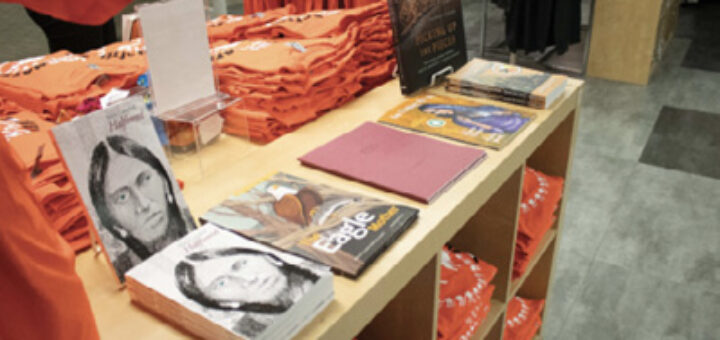MRU’s Journey to Indigenization

By Liam Rockliffe, Contributor
Mount Royal University (MRU) hosts its very own truth and reconciliation events to be held between Sept. 22 and Oct. 4.
These events hold special meaning for all Canadians especially after the discovery of 215 unmarked graves that were found in Kamloops, B.C. This discovery magnified the focus on truth and reconciliation and brought light to the injustices of residential schools. This year’s events focus on those who survived residential schools, and honours them in their legacy.
The reason why Journey to Indigenization starts on the 22nd instead of the 30th, which is the National Day of Truth and Reconciliation, is because the 22nd marks the original signing of Treaty 7.
Signed by the Kainai, Nakoda, Îyârhe Piikani, Siksika, and Tsuut’ina, in 1877, Treaty 7 allowed a transnational railway to be built.
To commemorate the signing of Treaty 7 the Survivor Flag shall be raised at MRU. This flag honours those who survived the residential schools, and contains nine symbols–10 including the colour–all which hold important factors of the effect of residential schools, while also maintaining Indigenous culture and values.
The colour orange has represented truth and reconciliation since the beginning of the movement in 2008, stemming from a story of survivor, Phyllis Webstad, who had her hopes and dreams–as well as her shiny new orange shirt–stripped from her by residential schools. Throughout the 13 days of Journey to Indigenization, Mount Royal will be lit up in orange lighting at several locations: Charlton Pond, the recreation pool, East Gate and the T-wing Courtyard tipis. These lights will uphold a constant reminder of the importance that these days hold.
The National Centre for Truth and Reconciliation (NCTR) is also holding virtual “lunch and learns” everyday at 11:30 AM and run for 50 minutes. These info sessions will provide listeners with history from First Nations, Métis, and Inuit knowledge keepers–showing many the “other side” of history. These lessons will involve residential schools, unconscious bias and stereotypes, current impacts and discrimination, rights of Indigenous people, and rounding it off, the path to reconciliation.
Journey to Indigenization
From Sept. 25 to 28, faculty, students, and elders alike will be sharing stories, presentations, and efforts to the general public. The elders have been requested individually by organizers and generally have a relationship with the presenters or the university as a whole. These sessions are available for pre-registration.
The Ani to Pisi (spiderweb) event on Sept. 28 is a creation story which is being used and utilized on MRU’s path to reconciliation. This event will include creating a human spiderweb which responds to vibrations, and deals with them as they occur.
The Ani to Pisi event is supported by Elder Roy Bear Chief who is ingrained in learning at MRU specifically in the health, community, and education faculties. Elder Clarence Wolf Leg, a doctor of Law honorary degree recipient will be opening the Ani to Pisi event.
John Fischer, the interim associate vice president of indigenization and decolonization, provides some insight into the inner workings of these events. The office of indigenization and decolonization has partnered with the Iniskim Centre, to provide opportunities to recognize the National Day for Truth and Reconciliation.
“The general principles about Truth and Reconciliation Week is to acknowledge what we are doing as a university in learning about the impacts of colonization and what the days that we are acknowledging represent,” Fischer says.
“[It’s] important for MRU students and faculty to recognize the National Day of Truth and Reconciliation and also recognize the Sisters in Spirit march and the impact on missing and murdered Indigenous girls.”
Son of a survivor
The meaning of truth and reconciliation hits incredibly close to home for Fischer. His mother, a residential school survivor, passed away last July. He says this week is an “acknowledgement of how [residential schools] affected [Indigenous] families in ways that we know and ways that sometimes we don’t”.
This year’s truth and reconciliation events for Fischer are focused on “what’s happening in our universe”. Specifically, MRU’s actions in the past, present, and future.
Rounding off Journey to Indigenization is Sisters in Spirit Day. Held nationally on October 4th, Sisters in Spirit Day is a sombre convocation for murdered and missing Indigenous women, girls, and two-spirit. Everyone is encouraged to wear red in support of the families and victims who have suffered this loss.
On this day, MRU will hang red dresses from trees. This is inspired by Jaime Black, a Métis Artist and founder of the REDress Project. In Black’s own words, “the project has been installed in public spaces throughout Canada and the United States as a visual reminder of the staggering number of women who are no longer with us.”
Outside of campus, Awo Taan Healing Lodge Society is hosting their 20th annual Sisters in Spirit Vigil at 11:30 AM at downtown Calgary. This peace march, complete with drum circles, honour, and traditional ceremony–honours those who have been lost, while also fighting for no more “stolen sisters”.
MRU’s Journey to Indigenization is an event anyone can attend, and holds the power to break down the barriers between colonization and indigenization.


